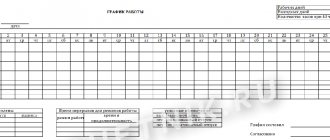Home / Labor Law / Personnel Management / Personnel Records
Back
Published: 08/07/2016
Reading time: 9 min
0
7246
Labor legislation provides for several modes (schedules) of working time distribution. Each employer is obliged to develop and establish a work schedule that does not contradict the legislative norms reflected in the Labor Code and local documents, and also satisfies the production or commercial needs of a given legal entity.
The working hours can be established by local documents, for example, a collective agreement or special rules recorded in writing. Typically, these documents are agreed upon with trade union bodies in order to avoid unnecessary disputes with the work team .
Such a schedule is individual for each individual enterprise, organization or company, as it reflects the characteristic features of the activities of a legal entity. However, there are general scheduling rules that employers need to consider.
- Legislation
- Main types and their features Single-shift schedule
- Irregular schedule
- Flexible work schedule
- Shift schedule Shift schedule
Labor Code on shift work schedules
If a company operates on a shift schedule, the employer must take into account the nuances provided for by labor legislation.
Shift work The Labor Code of the Russian Federation (Article 103) allows the following :
- if the duration of the production process is higher than the permissible duration of daily work;
- for the efficient use of equipment, increasing the volume of products (works, services).
Typically, internal company local acts and labor contracts establish the duration of workers' shifts and the order of their alternation with rest periods between shifts.
A ready-made solution with detailed explanations and examples of wording from ConsultantPlus will help you draw up an employment contract with a condition on a shift work schedule. If you do not have access to this legal system, a full access trial is available for free.
The materials on our website will help you understand the nuances of drawing up other documents that determine the work and rest schedule of employees:
- “Internal labor regulations - sample 2021”;
- "Unified form No. TD-1 - Employment contract."
To properly organize shift work, shift schedules are drawn up in compliance with the following conditions:
- the schedule may include working in several shifts (2, 3 or more);
- working 2 shifts in a row is prohibited;
- when drawing up a schedule, the employer will have to take into account the opinion of the trade union body (if there is one in the company);
- It is necessary to familiarize employees with the shift schedule at least 1 month before it comes into force.
Work schedule 1/3 - how is it? —
Shift work - work in two, three or four shifts - is introduced in cases where the duration of the production process exceeds the permissible duration of daily work, as well as in order to more efficiently use equipment, increase the volume of products or services provided, as well as in hospitals and transport sphere.
The working hours, including the number of shifts per day, are established by internal labor regulations, collective agreements, agreements, and for employees whose working hours differ from the general rules established by a given employer - by an employment contract.
Types of shift schedules
Depending on the company’s operating technology, shift schedules with different durations and a combination of working periods of time and rest periods may be established for different positions.
For example, for workers in such a specific field as railway transport, schedules with the following parameters can be developed:
- day and night shifts, rest after night work and a day off followed by a new work shift;
- 2 working days of 11 hours each (no night work) alternate with two consecutive days of rest;
- work shifts are combined with rest in the following combination: a working day after three days of rest.
The first form of shift work is typical for operators, station attendants, wagon inspectors and repairmen, rolling stock repairmen and other workers who provide round-the-clock reception, access and processing of rolling stock.
The specific nature of the activities of workers in the second group does not require round-the-clock presence at workplaces, but does not allow any breaks in daytime work shifts. Such workers include dispatchers for the accounting of cars requiring uncoupling repairs and other similar positions.
Working in the “every three days” mode is typical for the security service of premises and territory. We will consider further how to calculate a shift schedule for this category of workers.
Calculation of shift work schedule
To calculate the working time schedule for shift work “in three days”, you need to:
- establish a summarized accounting of working time (Article 104 of the Labor Code of the Russian Federation);
- reflect separately in the schedule work during the day and at night;
- take into account the legally established duration of breaks for rest and meals (no more than 2 hours and no less than half an hour, Article 108 of the Labor Code of the Russian Federation);
- personalize the accounting of time actually worked by each employee (Article 91 of the Labor Code of the Russian Federation).
You can familiarize yourself with the documents used to record actual time worked using the materials on our website:
- “Unified form No. T-12 - form and sample»;
- “Unified form No. T-13 - form and sample».
Important! When drawing up a working time schedule, it is necessary to take into account the legally established condition of 42 hours of weekly continuous rest (Article 110 of the Labor Code of the Russian Federation).
The results of calculating the parameters of the shift schedule and its results are usually presented in tabular form and posted for public viewing.
The employee must learn about the parameters of the shift schedule at least 1 month before it comes into force. The responsibility for such familiarization lies with the employer (Article 103 of the Labor Code of the Russian Federation).
Find out what are the nuances of providing annual leave to employees with a shift schedule from ConsultantPlus. Get trial access to the system and go to the Ready-made solution.
Setting up work schedules in 1C: Salary and personnel management edition 3.1. (ZUP 3.1.)
In some organizations, there are employees who work on non-standard schedules (not five or six days). For this purpose, there are special work schedule settings in the ZUP 3.1 program. In this article, we will look at an example of a watchman’s work schedule. If you set up your schedule correctly, you will not have to create a time sheet every month and enter night hours.
Let's consider an example when an organization has 4 security guards working 24 hours every other day, alternately from 08:00 to 08:00 the next day. According to the labor code, the working day is divided into day and night hours: from 22:00 to 00:00 and from 00:00 to 06:00 night hours; from 06:00 to 08:00 and from 08:00 to 22:00 - daytime. I separated them for a reason, but for a better understanding of our example.
To correctly calculate the night hours in the schedule, it is necessary to separate the day hours from the night hours.
To make it easier to understand this diagram, I’ll draw you a table of watchmen’s shifts:
Rice. 1
In the table, I took a random four days as an example. I explain the numbers in the table:
14 (in the 1st cell) is the number of daytime hours on 02/01 that Ivanov worked, i.e. from 08:00 to 22:00.
2 (in the 1st cell) is the number of night hours on 02/01 that Ivanov worked, i.e. from 22:00 to 00:00.
2 (in the 2nd cell 02.02) is the number of daytime hours on 02.02 that Ivanov worked, i.e. 6:00 to 8:00.
6 (in the 2nd cell 02.02) is the number of night hours on 02.02 that Ivanov worked, i.e. from 00:00 to 6:00.
As a result, Ivanov worked for us from 08:00 01.02 to 08:00 02.02 and he was supposed to pay 16 hours of daytime hours and 8 hours of nighttime hours.
By analogy with other watchmen. From the table it is clear that for 4 guards a cycle of 4 days is required. Also, to set up such shifts, you will need to create 4 schedules for each guard.
Let's move on to a visual example of how to do all this in ZUP 3.1.
To get a consultation
To edit work schedules, go to the Employee Work Schedules directory (on the Settings tab).
Rice. 2
Click the “create” button to create a new chart. On the start page of the chart we write the name of the chart because we will have 4 different schedules for each watchman, let's call them the names of the watchmen. Then click on the “Change chart properties” link.
Rice. 3
To get a consultation
In the chart properties, specify the following settings as in the picture.
Rice. 4
In the filling method, put a dot on “By cycles of arbitrary length” because Watchmen work without taking into account weekends and can work both Saturday and Sunday. We also uncheck the “When filling out, take into account holidays” box, because guards can work this way on holidays as well.
In the Time Types tabular section, check the “Night Clock” view. If you do not have this type of time, then you need to enable it in the payroll settings. To do this, go to Settings - Payroll. We find the link Setting up the composition of charges and deductions and follow it, there we go to the Hourly payment tab and check the “Night hours” checkbox.
Rice. 5
To get a consultation
You can also configure the percentage of payment for night hours in the organization’s accounting policy.
Rice. 6
Now the time type “night hours” should appear in the tabular part of the chart properties. Check the box and proceed to adding shift cycles in the “Work Schedule” tabular section. Using the “add” button, we add 4 days and put the number of hours in the “Attendance” and “Night hours” columns according to the table that I gave above.
Rice. 7
Rice. 8
Get a consultation The report date can be specified any date from which this work schedule will begin to apply.
After filling out, click “Ok” in the chart settings. After which our schedule will be filled with day and night hours for the whole year.
Rice. 9
The schedule for the first guard is ready, write it down and close it. Next, you need to make the same graphs for the remaining guards.
We create a schedule for watchman Petrov. In the chart properties we indicate the hours according to our table.
Rice. 10
To get a consultation
Fig.11
Save the settings. The schedule is also filled in immediately automatically.
Fig.12
The schedule for Petrov is ready, we write it down and close it. By analogy, we make the remaining 2 graphs for Sidorov and Mikhailov.
For Sidorov.
To get a consultation
Rice. 13
For Mikhailov.
Rice. 14
To get a consultation
After creating all the schedules, you need to assign these schedules to employees. The schedule can be changed using the document Personnel transfer or Personnel transfer list (Personnel - Hires, transfers, dismissals).
Rice. 15
And it is imperative that the guards have a basic accrual of salary (by the hour).
Rice. 16
All necessary settings have been completed. You can check by creating a document Calculation of salaries and contributions.
Here we will see that the employee did not have any absences and the salary was accrued in full for the entire month. And the additional payment for night work was automatically calculated.
Rice. 17
There are actually a lot of work schedules, and I showed you one of them. I hope that in the same way you will be able to independently set up the schedule you need. If something doesn’t work out for you, our specialists are ready to help you in this situation.
*****
If you have any questions about accounting, our specialists are ready to help you!
Order a specialist by phone (8351)222-00-22
Do you have any questions?
Call or write. Do you want to place an order? Leave a request
We are in social networks! Subscribe!
Remuneration for shift work: nuances
Payroll calculation for shift work has its own characteristics compared to similar calculations in a 5-day working week with days off at the end.
With a shift schedule, the usual weekends for everyone (Saturday and Sunday) can be scheduled as working days, and the shift worker’s rest will fall during working hours.
The calculation of wages for a shift worker is specific in that the number of working hours according to the schedule may differ from the norm in the direction of increase (planned overtime) or create a planned shortfall.
Important! When using summarized working time accounting, the annual number of overtime hours cannot exceed 120 (Article 99 of the Labor Code of the Russian Federation).
To avoid errors in salary calculations during shift work, it is necessary to carry out a reconciliation procedure for the following indicators at the end of the accounting period established by the company:
- hours actually worked by the employee according to the schedule;
- number of working hours during the accounting period according to the norm.
If, upon comparison, the first indicator exceeds the second, it is necessary to calculate and pay for processing.
Important! In accordance with clause 5.5 of the resolution dated 05.30.1985 of the State Committee for Labor of the USSR No. 162, All-Union Central Council of Trade Unions No. 12-55, overtime is subject to payment in time and a half (the first 2 hours, falling on average for each working day of the accounting period) and double (subsequent hours of work).
A similar approach when paying overtime was confirmed by the Supreme Court of the Russian Federation (Section 5 of the review approved by the Presidium of the Supreme Court of the Russian Federation on February 26, 2014).
We will consider an example of calculating the salary of a shift worker with overtime in the next section.
Operating mode concept
A working mode (hereinafter referred to as RR ) is a certain procedure in which productive hours are distributed in a certain time period: , etc. Thus, a time reference point for the beginning of work activity and a time reference point for its end are established.
The period of lunch, technical or some special break is also reflected in the RR. In addition, the idea of RR is inextricably linked with the idea of “rest mode” . That is, this is a certain order of actions where productive hours and rest rhythmically alternate .
This concept therefore includes the employee’s days off too.
Work activities, breaks and days off are regulated by law.
The idea of WP differs significantly from the idea of “working hours” (hereinafter referred to as WP). PP is a concept that exists for calculating the working hours of an organization. RWP is a concept that exists to record the working hours of employees of this organization.
RR can be intermittent or continuous . When intermittent, the organization does not work on certain days of the week, which are reserved for weekends or certain hours , for example, at night.
With continuous, the organization works all weeks, around the clock .
It follows that the employee’s RR is directly dependent on the organization’s RR . The RR of an enterprise or any other organization is determined by the owner, local government body, ministry, etc. Moreover, the RR is the sphere of regulation of administrative legislation, not labor legislation. RRV, on the contrary, is regulated by labor legislation :
- Unstandardized PP is a special point of view. With this procedure, individual employees occasionally perform their duties in excess of the established standard working hours. To approve such a work procedure, a written order from the manager is required, as well as the employee’s consent (signature). At the same time, overtime is not considered overtime activity, and therefore is not compensated financially.
- RR can be single-shift . This scheme assumes one-shift operations. It can be daily or weekly, as well as cumulative. It all depends on the activities of the enterprise.
- RR can be replaceable . This type is considered the most common. In shift work, workers alternate shifts sequentially.
Other types of modes:
- Shift worker . In this rhythm of activity, workers work far from home. After a hard day at work, they do not return home. As a rule, certain conditions are created for them: accommodation and sometimes food are provided. For overtime activities, under this scheme, additional payment is expected.
- Fragmented Day . Productive hours, with this scheme, are divided into parts.
How to calculate salary for shift work
Let's look at an example.
The operational dispatcher has a summarized recording of working time with a recording period of 1 month. Work is carried out on a 2/2 schedule (2 working days of 11 hours each, followed by 2 days off).
According to the schedule, the dispatcher worked 165 hours for the month against the norm of 160 hours. The accountant made the following calculation (the hourly tariff rate of the dispatcher is 260 rubles):
- salary for hours worked: 165 hours × 260 rubles/hour = 42,900 rubles;
- processing hours: 165 – 160 = 5 hours;
- number of working days in the accounting period: 165 hours / 11 hours per shift = 15 days;
- calculation coefficient (average duration of overtime work per 1 working day of the accounting period): 5 hours / 15 days. = 0.33 hours/day. (does not exceed 2 hours a day, which corresponds to payment for overtime hours at one and a half times the rate);
- amount of additional payment for overtime work: 260 rubles/hour × 5 hours × (1.5 – 1) = 650 rubles;
- total salary: 42,900 + 650 = 43,550 rubles.
With the same approach, you can calculate differently:
- salary for standard hours: 160 hours × 260 rubles/hour = 41,600 rubles;
- additional payment for overtime: 5 hours × 260 rubles/hour × 1.5 = 1,950 rubles;
- total salary: 41,600 + 1,950 = 43,550 rubles.
The choice of calculation method does not affect the final result.
Work schedule 2 2 3 is like a day shift
- It can be established by internal labor regulations, regulations, or a collective agreement.
- Working time is the period of time during which the employee performs work duties in accordance with the employment agreement.
- Breaks, which can last from half an hour to two hours, are not included in working hours.
- The working time schedule determines the length of the working week, shifts, irregular working hours, break times, the beginning, end of a shift and their number in one day, the alternation of working days with non-working days and is regulated by internal labor regulations and an employment agreement.
- The Labor Code distinguishes the following working hours: This schedule is called a single-shift work schedule.
- In cases of daily recording of work time, any work beyond the norm is overtime.
- With this accounting, the maximum duration of a shift is not established by law.
- Irregular working hours are a work mode in which certain employees, by order of the employer, are involved in the performance of assigned functions outside the normal work hours, and consists in the employee carrying out his work activities according to the general work schedule, but the ability to be involved in performing duties beyond the work shift.
However, this requires working out total working hours during a certain accounting period.
The main element of the regime is a flexible work schedule, which is established by agreement of the parties upon admission or during the work process.
The establishment of such a regime is formalized by order of the employer and does not change the labor rights of the employee: rationing of labor, payment, provision of benefits, length of service, etc.
Shift work is working in shifts throughout the day, with workers working different shifts for a certain period of time, for example, three days. For example, in order to increase the volume of services provided or products produced, when the production process exceeds the permissible duration of work.
Under this regime, each group of workers works according to a shift schedule.
Workers are provided with continuous rest - 42 hours per week and between-shift rest - double the duration of the shift. If 50% of the shift duration falls on the time period from 22.00 to 06.00, then such a shift is considered a night shift.
Shift working hours are a form of labor process not at the place of residence of workers, when the possibility of their daily return to their place of residence is excluded.
A shift is a period consisting of time spent performing work and rest time between shifts.
The legislator determines the duration of the shift, which cannot exceed one month, but in exceptional cases is extended to three months.
In this case, the shift can last 12 hours daily.
With this method, a summarized time record is established, which covers the travel time from the employer’s location to the place of work, as well as vacation time falling within this calendar period of time.
The working hours with the division of the working day into certain parts are determined by the Labor Code of the Russian Federation.
For work of a special nature or for work with unequal intensity during a shift, the working day must be divided into parts.
As a rule, such work is related to serving the population: passenger transport, communications, trade.
Video on the topic:
>Plot a graph of a function online
Holiday salary supplements for shift workers
With regard to payment for holidays that fall during work shifts, the general procedure established by labor legislation applies.
Important! In accordance with Art. 153 of the Labor Code of the Russian Federation, work on holidays is paid at least double the amount. Holidays and non-working days are listed in Art. 112 Labor Code of the Russian Federation.
Following the legally defined minimum level of holiday surcharges, the employer has the right to set its own amount of such surcharges. Their maximum limit is not regulated by law. The procedure for paying for holidays, like all other important nuances of salary calculations, must be reflected in the internal local act of the company (collective agreement, regulations on wages, etc.).
When calculating the salary of a shift worker, provided that in the billing month his work shifts coincided with non-working holidays, the following must be taken into account:
- if an employee starts his shift at 8:00 a.m. on a holiday and his shift lasts 11 working hours, all hours actually worked are subject to holiday surcharge in full;
- if part of the work shift falls on the night period (for example, from 20:00 on a holiday until the morning of the next day), the calculation of the holiday surcharge must be made only up to 24 hours of the holiday (in this case, 4 hours) - from 20:00 to 24 :00 holiday.
Results
Shift work refers to working under flexible working hours. Labor legislation regulates the specifics of its organization, accounting and payment.
The employer needs to correctly calculate the duration of work shifts and rest breaks, draw up a shift schedule, promptly familiarize employees with it, record the time actually worked by employees, and then correctly calculate wages taking into account the peculiarities of shift work.
You can find more complete information on the topic in ConsultantPlus. Free trial access to the system for 2 days.









